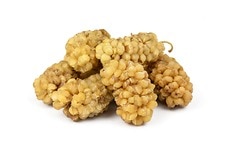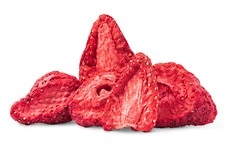Food & Snack Sources of Vitamin C
Vitamin C, or ascorbic acid, is essential to any diet and plays a necessary role in the growth and repair of organic tissue. One of the things for which vitamin C is directly responsible is the production of the protein collagen. Collagen helps the body make ligaments and tendons, along with cartilage, skin, and blood vessels. People who get an adequate supply of the vitamin in their daily diet may experience faster wound healing and benefit from stronger bones and teeth than those that do not (University of Maryland Medical Center [UMMC], 2013).
Which Foods Are Best for Vitamin C?
There are many foods that offer a good source of ascorbic acid. Some of the most common sources include oranges, strawberries, red peppers, kiwifruit, broccoli, leafy greens, cauliflower, watermelon, and pineapple (UMMC, 2013). However, it is also possible to get the vitamin from green peppers, tomatoes, papaya, grapefruit, winter squash, and mango. Whether people cook with these foods or simply eat them as snacks, this selection offers options that contribute to an adequate intake for the vitamin.
What Happens with a Vitamin C Deficiency?
People who are not getting a sufficient supply of vitamin C can become deficient. Some of the first signs of vitamin C deficiency include fatigue, weight loss, and irritability. If left untreated, the condition can progress such that symptoms become more severe.
A continued deficinecy can lead to symptoms such as poor wound healing, loose teeth, swollen gums, and spontaneous hemorrhaging, along with edema in the lower extremities and painful bleeding in the joints. Most people who are low in vitamin C may not be aware of their deficiency until symptoms begin; but, these symptoms can be reversed with proper treatment and supplementation (Johnson, 2014).
What Are the Best Ways to Assure a Healthy Intake of the Vitamin?
Incorporating foods that provide ascorbic acid into your daily routine of healthy eating is one of the best ways to ensure that sufficient levels of the nutrient are attained; however, another way to meet your nutritional needs is through supplementation. In fact, it may even be required for those who have a very low level of the vitamin, as large quantities are needed to restore depleted levels (Johnson, 2014). Before you start taking a supplement, make sure to check with your healthcare provider to make sure it’s right for you.
Do Other Nutrients Increase or Decrease Absorption?
In order to take vitamin C effectively, it is important to take it on its own or with supplements that do not cause absorption issues. While the general population can actually stand to benefit from the vitamin's effect of an increased absoprtion of non-heme iron, individuals with select conditions may face increased risk of excess iron intake (National Institutes of Health, 2016).
For more on vitamin C, check out our comprehensive resource on the nutrient here, and be sure to check out our articles on food and snack sources of calcium and iron.
Recommended Recipes
Searching for meals and snacks you can make that are guaranteed to get you your Daily Value (DV) for vitamin C? Look no farther than to the recipes below for vitamin-rich foods for any occasion.
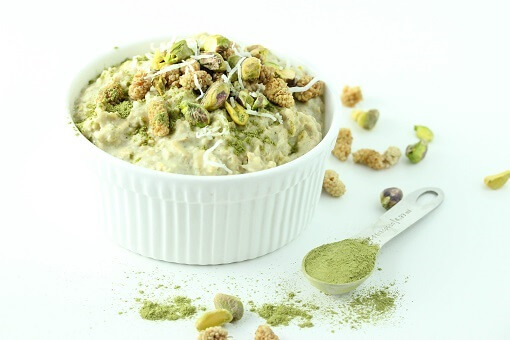
Moringa Oatmeal Recipe
This gluten-free and vegan recipe provides a potent source of the nutrients you need, including an astounding 64% of the DV for vitamin C in each serving.
Ingredients: Gluten-free rolled oats, almond milk, agave or maple syrup, vanilla extract, moringa powder, pistachios, dried mulberries, unsweetened shredded coconut, chia seeds.
Total Time: 10 minutes
| Yield: 4 servings
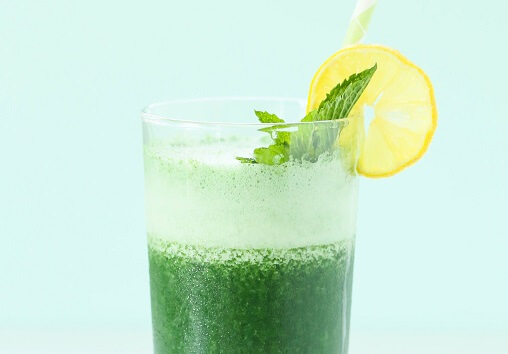
Spirulina Smoothie Recipe
This superbly sweet super smoothie combines the nutritive value of spirulina with that of fruits and veggies for a fast means of getting your vitamin C.
Ingredients: Spirulina, banana, fresh spinach, apple juice, crushed ice, lemon juice.
Total Time: 2 minutes
| Yield: 2 smoothies
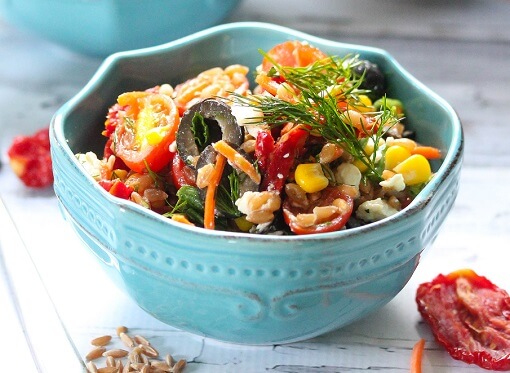
Farro Vegetable Salad Recipe
This delectable dish supplies an absolutely salacious spread of cheese, veggies, whole grains, and fruits that offer an abundant 56% of the DV for vitamin C in each 1¼-cup serving.
Ingredients: Organic farro, sun dried tomatoes, frozen corn (thawed), scallions, black olives, feta cheese, cherry tomatoes, shredded carrots, salt, fresh dill, fresh mint, extra virgin olive oil, balsamic vinegar.
Total Time: 1 hour
| Yield: 6 servings
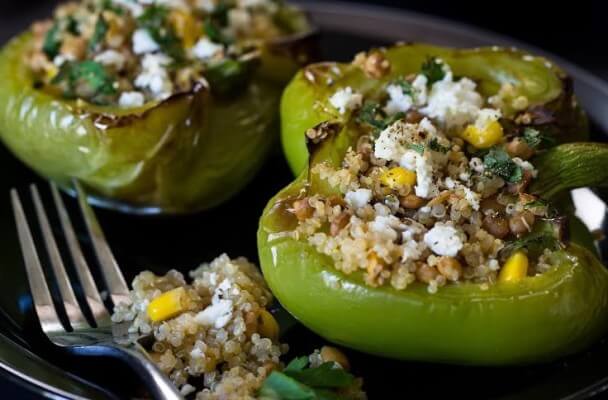
Quinoa Stuffed Peppers Recipe {gluten-free}
A dinner option that is ideal for those that know they are lacking in their vitamin C intake, these delectable stuffed bell peppers offer an overwhelming 46% of the DV for the mineral per 100 grams!
Ingredients: Quinoa, green bell peppers, canned lentils, fresh spinach, feta cheese, frozen corn (thawed), salt, black pepper.
Total Time: 40 minutes
| Yield: 6 servings (8 half-peppers)
Healthy Snack Recommendations
These delicious treats act as a means of adding vitamin C to any diet with relatively little effort. Many also include sources of iron and calcium to capitalize on the increased bioavailability for the minerals provided by vitamin C.
Healthy Eating
- Healthy Highlights
- 5 Uses for Cacao Powder
- 5 Ways to Eat Farro
- 6 Best Gluten-Free Foods
- Alcohol and the Body
- Almond Flour Recipes
- Anti-Aging Superfoods
- Beat the Afternoon Slump
- Benefits of a Plant-Based Diet
- Benefits of Baobab
- Benefits of Cashews
- Benefits of Coconut Oil for Hair
- Benefits of Coconuts
- Benefits of Dates
- Benefits of Fenugreek
- Benefits of Garcinia Cambogia
- Benefits of Goji Berries
- Benefits of Kale Chips
- Benefits of Monk Fruit Sweetener
- Benefits of Peanuts
- Benefits of Pecans
- Benefits of Pistachios
- Benefits of Pumpkin Seeds
- Benefits of Spelt Flour
- Benefits of Steel Cut Oats
- Benefits of Sunflower Seeds
- Benefits of Tiger Nuts
- Benefits of Turmeric
- Benefits of Walnuts
- Benefits of Wheatgrass
- Best Food Fads
- Cacao vs Cocoa
- Caffeine-Free Energy Foods
- Chocolate That's Good for You
- Diet vs. Exercise
- Fat Burning Foods
- Food Myths Debunked
- Foods for Bone Density
- Foods for Colon Health
- Foods for Healthy Hair
- Foods for Healthy Skin
- Foods to Help Sleep
- Foods to Reduce Stress
- Green Tea Benefits
- Healthy Baking Flours
- Heart Healthy Habits
- High Protein Health Risks
- How to Boost Your Metabolism
- How to Lose Weight While Aging
- How to Throw a Vegan BBQ
- Kaniwa vs Quinoa
- Little Health Foods
- Low-Carb: Fad or Friend?
- Making Healthier Desserts
- Mediterranean Diet Meal Plan
- Natural Beauty Products
- Nuts for Weight Loss
- Preparing Vegan Meals
- Preventing Muscle Degeneration
- Rare Superfoods
- Reduce Sugar Intake
- Save Time By Going Vegan
- Smarter Snack Swaps
- Smoothie Ingredients
- Soy Protein vs Whey Protein
- Starting a Plant-Based Diet
- Steel Cut vs Rolled Oats
- Sugar Substitutes
- Vegan Proteins
- Vegan Substitutions for Fall Recipes
- Why Go Vegan
- Healthy Meals
- Healthy Recipes
- Sports Nutrition
- Nutrition and Special Diets
- 21 Day Fix
- 5 Popular Diet Similarities
- Alkaline Diet
- Anti-Inflammatory Diet
- Calorie Counting
- Carb Cycling Diet
- Celiac Disease
- Cholesterol
- Clean Eating
- Crohn's Disease
- DASH Diet
- Detox Diet
- Diabetes
- Diabetes Diet
- Diet Pill Dangers
- Fat Burning Foods
- Gluten-free Diet
- Glycemic Index
- Heart Health
- High Blood Pressure Diet
- High Fiber Foods
- How to Eat Healthy
- How to Lower Blood Pressure
- Hypertension
- IBS Diet
- Ketogenic Diet
- Liquid Diet
- Low GI Foods
- Low-Carb Diet and Foods
- Low-Fat High-Carb Diet
- Mediterranean Diet
- Mediterranean Diet Foods
- Military Diet
- Nutrition Labels Explained
- Paleo Diet
- Raw Food Diet
- Superfoods
- Sustainable Weight Loss
- Thrive Diet
- Vegan Diet
- Vegetarian Diet
- Weight Loss Shakes
- Whole30
- Vitamins, Minerals & Nutrients


